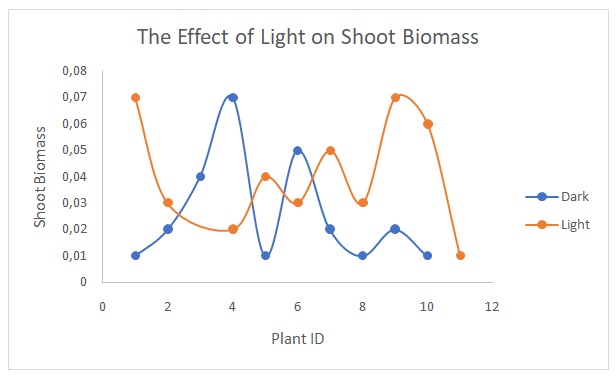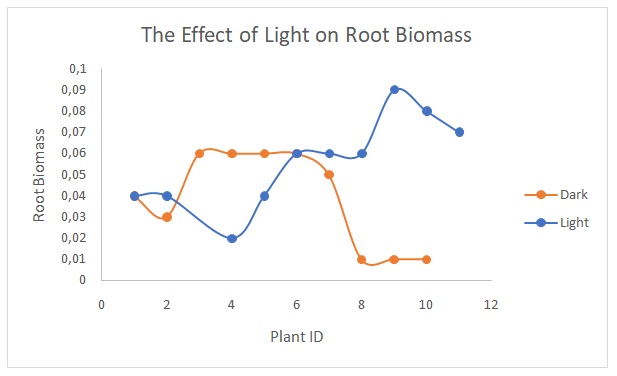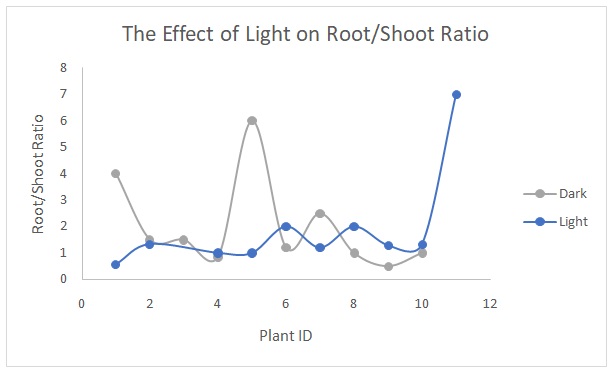Abstract
The growth and development of plants require various factors, including water, light, warmth, and nutrients. The purpose of this paper was to determine the origins of plant growth and ascertain the role of light in the growth and development of plants. Twenty seeds in potting soil were grown in light and darkness, followed by the measurement of root biomass, shoot biomass, as well as the root to shoot ratio. It was observed that plants grown under light conditions had a higher shoot and root biomasses compared to those grown in darkness. However, the root to shoot ratio was higher in plants grown in darkness. These observations were explained by the role of light in photosynthesis and the subsequent deposition of manufactured sugars in the roots and shoots. It was concluded that light plays a vital role in the healthy growth of plants.
Introduction
Plant physiology is a branch of science that deals with the life processes of plants from germination, growth, development, and reproduction. Preliminary observations by primitive humans were that plants thrived in the presence of moisture, warmth, and sunlight and that the addition of manure to soil enhanced the growth of plants. This knowledge was applied in agriculture for food production for many centuries. Early investigations of plant physiology were based on this fundamental knowledge regarding plant growth (Kutschera et al. 657).
Early experiments on plant growth questioned the source of materials used for plant growth. One physician hypothesized that water was the main material needed for plant growth. He tested this supposition by growing a tree in a known volume of soil using only rainwater. At the end of his experiment, only two ounces of soil had been used up. Even though he suspected the involvement of carbon dioxide, he quickly ruled it out because he could not find the relationship between wood and diffuse gas. Antoine Lavoisier discovered that carbon and oxygen were the major constituents of organic matter (Nicolaou 105). Later on, three scientists discovered that in the presence of light, plant leaves took in carbon dioxide and produced similar amounts of oxygen. The opposite reaction took place in darkness, and water was involved in the two processes. It was then concluded that light energy was transformed into chemical energy in the form of organic carbon, which was important for the growth and development of plants. Therefore, by the end of the nineteenth century, it was established that photosynthesis was a crucial synthetic process for plant growth (Métioui et al. 280).
The purpose of this paper is to describe the origins of plant growth and identify the impact of light on the development of plants. It is hypothesized that the presence of light enhances the growth and development of plants.
Methods
Twenty sets of plant seeds were planted in potting soil and allowed to germinate. Thereafter, 10 of the plants were kept in darkness and allowed to grow, whereas the other 10 plants were exposed to light. The effect of light and darkness on the growth and development of the plants was then determined by measuring parameters such as root and shoot biomass as well as root to shoot ratio. The measured values were then plotted as shown in Figures 1, 2, and 3 in the results section.
Results
Higher rates of growth were observed when the plants were grown in the light compared to darkness. The mean shoot biomass in light conditions was higher (0.046) than when the plants were grown in darkness (0.026). Similarly, higher root biomass of 0.056 was recorded in plants that were exposed to light compared to those left in the dark (0.039). However, a higher root to shoot ratio of 2.005 was calculated for plants growing in darkness compared to a ratio of 1.872 for plants growing under light conditions. Figures 1, 2, and 3 indicate the shoot biomass, root biomass, and root to shoot ratios of the plants under light and dark conditions.



Discussion
The purpose of this experiment was to determine the impact of light on the growth and development of plants. It was observed that growing plants in light led to higher root and shoot biomasses compared to when the plants were subjected to darkness. However, the root to shoot ratio was higher for plants grown in darkness than those grown in light conditions. These observations corroborated the hypothesis that light conditions would lead to improved plant growth. Biomass is a biomarker for the measurement of growth and development in plants.
In the presence of light energy, plants convert carbon dioxide and water into glucose and oxygen in a process known as photosynthesis (Freeman et al. 775). Therefore, the key role of light in plant development is to avail energy for photosynthesis, which in turn regulates the advancement of various life stages of a plant, such as germination of seeds, growth of vegetative parts, flowering, and tropism (van Gelderen et al. 1049). The quality of light and its duration are responsible for these phases of growth by controlling photoperiodic induction and photomorphogenesis. Plants have photoreceptors that are associated with light-sensitive signaling molecules. The two components work in synchrony to regulate physiological processes. Different plant functions are regulated by various wavelengths of light, which are detected by special photoreceptors that are found throughout the plant, especially in the shoots. However, roots also express these photoreceptors. For example, negative phototropism, the movement of roots away from light, is mediated by the perception of blue light by phototropin, which is sensitive to blue light (van Gelderen et al., 1050). Consequently, even though roots grow underground in darkness, they are highly sensitive to light, which explains the observed effect of the presence and absence of light on roots.
It is obvious that light occurs above the soil and not beneath it. Thus, numerous studies involving the interactions of plants with light have been done using plant shoots. However, studies focusing on root responses to light have been done in Arabidopsis. It has been noted that exposing roots to light hastens growth through processes mediated by reactive oxygen species and F-actins (Yokawa et al. 1). Conversely, growing Arabidopsis in darkness inhibits the dissemination of F-actin and transport of auxins. Charles Darwin and Francis Darwin suggested that the phytohormone auxin was responsible for the connection between apical parts of plants and the active growth of basal organs (Yokawa et al. 1).
Other studies suggest that nitrogen deficiency is responsible for high root to shoot ratios (Jiang et al. 28). However, this study did not measure nitrogen levels in the soil. Therefore, this claim can neither be supported nor refuted by the findings in this investigation.
Conclusion
In this experiment, it was observed that growing plants in the presence of light led to increased root and shot biomasses in addition to lower root to shoot ratios. Light is an important requirement for plant growth and development due to its involvement in the production of sugars through photosynthesis. The resultant sugars are used up in the development of plants, which leads to increased root and shoot biomass. Therefore, plants should receive adequate light for optimal growth.
Works Cited
Freeman, Scott, et al. Biological Science. 5th ed., Pearson Publishing Company, 2014.
Jiang, Suyu, et al. “Root Extension and Nitrate Transporter Up-Regulation Induced by Nitrogen Deficiency Improves Nitrogen Status and Plant Growth at the Seedling Stage of Winter Wheat (Triticum aestivum L.).” Environmental and Experimental Botany, vol. 141, 2017, pp. 28-40.
Kutschera, Ulrich, et al. “Julius Sachs (1868): The Father of Plant Physiology.” American Journal of Botany, vol. 105, no. 4, 2018, pp. 656-666.
Métioui, Abdeljalil, et al. “The Teaching of Photosynthesis in Secondary School: A History of the Science Approach.” Journal of Biological Education, vol. 50, no. 3, 2016, pp. 275-289.
Nicolaou, Kyriacos Costa. “The Emergence and Evolution of Organic Synthesis and Why it is Important to Sustain it as An Advancing Art and Science for its Own Sake.” Israel Journal of Chemistry, vol. 58, no. 1-2, 2018, pp. 104-113.
van Gelderen, Kasper, et al. “Light Signaling, Root Development, and Plasticity.” Plant Physiology, vol. 176, no. 2, 2018, pp. 1049-1060.
Yokawa, Ken, et al. “Light as Stress Factor to Plant Roots–Case of Root Halotropism.” Frontiers in Plant Science, vol. 5, 2014, pp. 1-9.